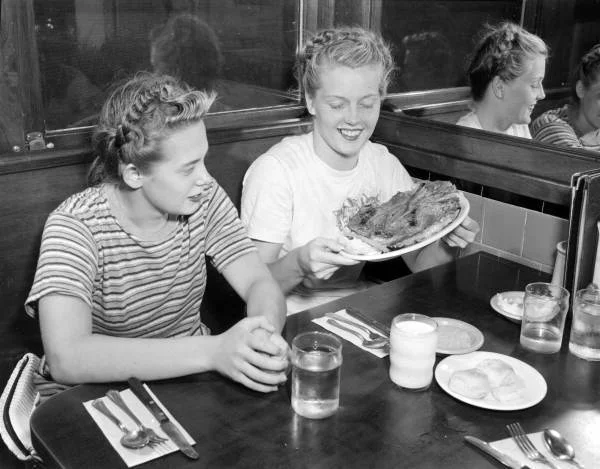Two Conch girls laugh at how silly their dinner looks without old sour in this photograph. STATE OF FLORIDA ARCHIVES/Contributed.
“Old sour” is a Conch tradition that has shaped the stories of our Key lime culture for generations. Fermented Key lime juice, salt and an optional bird pepper band together to create this culinary delight and, historically, it has been added to just about everything to come out of a Conch kitchen. Even the earliest Key lime pies were probably made with old sour, but through the years, our fair lady has become an endangered species and it is now up to us to save her.
Old sour probably originated with Bahamian Conchs looking to preserve the juice of local limes. Salt was a known preservative. Combining the two and storing them away from sunlight caused the juice to ferment into a tangy and zesty liquid. Bird peppers added the kick many crave.
A 1905 article about Key West in “The Country Gentleman” reads: “The lime is the main source of commercial citric acid. Thousands of over-ripe limes which rot on the ground could be utilized. In the early days, these limes were planted, no doubt, to supply wreckers and pirates with “sour” for the prevention of scurvy.” The statement confirms the idea that old sour, like condensed milk, was an important dietary supplement for sailors in our local waters.
In time, old sour evolved from a boat vitamin to the queen of most kitchens in the Keys. Jerry Curry and Max Foster each recall a childhood where the table wasn’t set until the Crystal hot sauce and old sour were out. The book “Turtle In Paradise” by Jennifer Holm describes cut-ups held by local children during the Depression. For a cut-up, each child brought in whatever food they found lying around or hanging from a tree to be cut up.The odd mix was placed in a large bowl, doused with old sour, and then passed around with a fork for each child to enjoy. Pineapple, guava, sugar apples, alligator pears, potatoes and onions were all used, with old sour added liberally to amp up each ingredient’s value as a treat.
Peter Krynicki told a story to The Hemingway Project about Ernest Hemingway and his “mob”getting together at Charles Thompson’s Fleming Street home, “where Phoebe (the cook) delighted the group with raw conch salad laced with onions and a spicy Key lime and salt brine sauce made locally and called Old Sour, a concoction Ernest continually called ‘Old Oscar.’”
No matter that he got the name wrong. Just as with Hemingway, the flavor of old sour earned a place in the history and hearts of people throughout the Keys.
Newspaper articles from the archives are peppered with tales from tourists describing their first old sour encounter at A&B Lobster House. Old society columns feature locals debating “the right way to do it” regarding peppers, refrigeration and the proper color for an old sour bottle. For a time, old sour was a staple in just about every restaurant in the Keys. Many of them kept a bottle on every table, but those days have gone. Conchs like Sheila Sands-Devendorf may surprise you with a bottle, and Chris Rehm might serve it to you at his home, but you would be hard pressed to find a restaurant with a ready bottle of old sour today.
Together we can change that. Chef Martha Hubbard serves up old sour at her Conch Revival Picnic. Charlie Bauer is going to set a bottle on every table at Smokin’ Tuna Saloon. Travis Doll is bringing it back to A&B Lobster House. Bobby Mongelli is going to put old sour on tables at Hogfish Bar & Grill and Geiger Key Marina.
You can help too. Old sour is simple to make. Mix up a batch at home and pass a few bottles on to friends. Drop off a bottle at your favorite restaurant. Share this article and the attached recipe with everyone you know involved with a restaurant in the Florida Keys, and request a little ol’ sour every time you dine.
No matter how your first batch of old sour turns out, you can take satisfaction in knowing that you are experiencing a great Conch tradition, and doing your part to keep an important part of our history alive. And I guarantee you, every drop is going to be heavenly . ..just like the fabulous Florida Keys.
Love & Limes!
Old Sour Recipe (1974, Alex Hawkes)
For each pint of freshly squeezed ripe lime juice (be sure none of the limes is the least bit spoiled, for this will ruin an entire batch), add one tablespoon of salt, stirring until dissolved. Allow to stand at room temperature for an hour or so. Strain at least twice through a fine sieve or double layers of cheesecloth, until juice runs through freely. Place in tightly covered bottles, adding hot peppers to some of the bottles if desired. Store in a dark, cool place (not under refrigeration) for at least one month prior to using as a super seasoning liquid with just about everything. Add old sour carefully, since it is rather formidable in its concentration.



